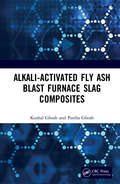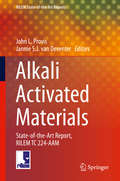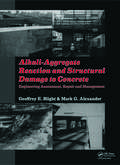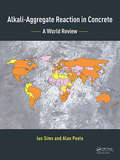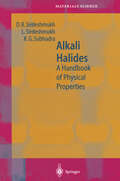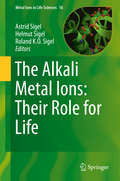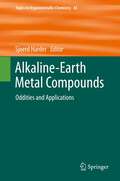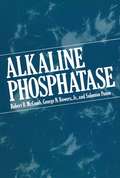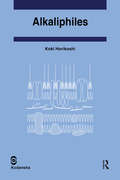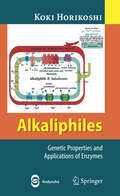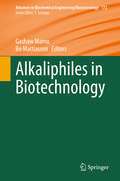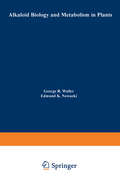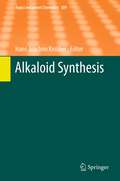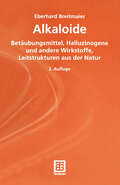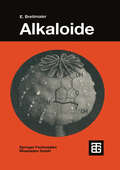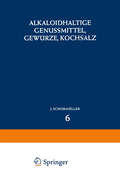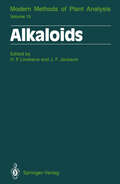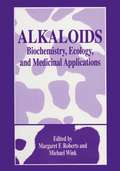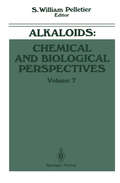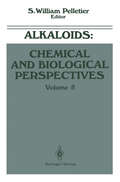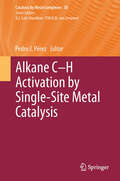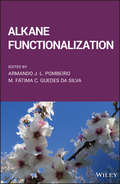- Table View
- List View
Alkali Activated Fly Ash: Blast Furnace Slag Composites
by Kushal Ghosh Partha GhoshThis book covers relevant synthesizing parameters, their interactions, and advantages of blending fly ash and blast furnace slag as source material, their relationship with mechanical properties and microstructure including guidelines to produce an optimal mix proportion. Further, it discusses related durability aspects, mechanical properties and reaction products and their inter-relationship. It explains phase characterization with XRD/SEM, change in the bond formulations with FTIR, FESEM and EDAX analysis. A mix design guideline based on empirical statistical concept has been put forward for professionals to manufacture customized activated fly ash composites in presence of slag. Aimed at graduate/senior undergraduate students, researchers in civil engineering, construction engineering, ceramics, material sciences, this book: Covers mechanical and microstructural properties, curing, durability of blended Alkali- activated composites with fly ash and blast furnace slag. Proposes a guideline for mix design on chemical compositions of ingredients, relationship of synthesizing parameters, workability, target strength. Describes sustainable green material manufacturing methodologies. Discusses issues like microstructural properties and reaction mechanism. Explores related modern experimental techniques like XRD, FTIR, MIP and so forth.
Alkali Activated Fly Ash: Blast Furnace Slag Composites
by Kushal Ghosh Partha GhoshThis book covers relevant synthesizing parameters, their interactions, and advantages of blending fly ash and blast furnace slag as source material, their relationship with mechanical properties and microstructure including guidelines to produce an optimal mix proportion. Further, it discusses related durability aspects, mechanical properties and reaction products and their inter-relationship. It explains phase characterization with XRD/SEM, change in the bond formulations with FTIR, FESEM and EDAX analysis. A mix design guideline based on empirical statistical concept has been put forward for professionals to manufacture customized activated fly ash composites in presence of slag. Aimed at graduate/senior undergraduate students, researchers in civil engineering, construction engineering, ceramics, material sciences, this book: Covers mechanical and microstructural properties, curing, durability of blended Alkali- activated composites with fly ash and blast furnace slag. Proposes a guideline for mix design on chemical compositions of ingredients, relationship of synthesizing parameters, workability, target strength. Describes sustainable green material manufacturing methodologies. Discusses issues like microstructural properties and reaction mechanism. Explores related modern experimental techniques like XRD, FTIR, MIP and so forth.
Alkali Activated Materials: State-of-the-Art Report, RILEM TC 224-AAM (RILEM State-of-the-Art Reports #13)
by John L. Provis Jannie S. J. van DeventerThis is a State of the Art Report resulting from the work of RILEM Technical Committee 224-AAM in the period 2007-2013. The Report summarises research to date in the area of alkali-activated binders and concretes, with a particular focus on the following areas: binder design and characterisation, durability testing, commercialisation, standardisation, and providing a historical context for this rapidly-growing research field.
Alkali-Aggregate Reaction and Structural Damage to Concrete: Engineering Assessment, Repair and Management
by Geoffrey E. Blight Mark G AlexanderSince AAR was first identified in 1940, it has been a subject dominated by studies of the mineralogy of AAR-susceptible aggregates, the chemistry of the AAR and related reactions and laboratory tests used to diagnose AAR and predict potential future swelling. Civil and structural engineers have found the literature bewildering and difficult to appl
Alkali-Aggregate Reaction in Concrete: A World Review
by Ian Sims Alan B. PooleAlkali-Aggregate Reaction in Concrete: A World Review is unique in providing authoritative and up to date expert information on the causes and effects of Alkali-Aggregate Reaction (AAR) in concrete structures worldwide. In 1992 a first edition entitled The Alkali-Silica Reaction in Concrete, edited by Professor Narayan Swamy, was published in a first attempt to cover this concrete problem from a global perspective, but the coverage was incomplete. This completely new edition offers a fully updated and more universal coverage of the world situation concerning AAR and includes a wealth of new evidence and research information that has accumulated in the intervening years. Although there are various textbooks offering readers sections that deal with AAR deterioration and damage to concrete, no other single book brings together the views of recognised international experts in the field, and the wealth of scattered research information that is available. It provides a ‘state of the art’ review and deals authoritatively with the mechanisms of AAR, its diagnosis and how to treat concrete affected by AAR. It is illustrated by numerous actual examples from around the world, and comprises specialist contributions provided by senior engineers and scientists from many parts of the world. The book is divided into two distinct but complementary parts. The first five chapters deal with the most recent findings concerning the mechanisms involved in the reaction, methods concerning its diagnosis, testing and evaluation, together with an appraisal of current methods used in its avoidance and in the remediation of affected concrete structures. The second part is divided into eleven chapters covering each region of the world in turn. These chapters have been written by experts with specialist knowledge of AAR in the countries involved and include an authoritative appraisal of the problem and its solution as it affects concrete structures in the region. Such an authoritative compilation of information on AAR has not been attempted previously on this scale and this work is therefore an essential source for practising and research civil engineers, consultant engineers and materials scientists, as well as aggregate and cement producers, designers and concrete suppliers, especially regarding projects outside their own region.
Alkali Halides: A Handbook of Physical Properties (Springer Series in Materials Science #49)
by D.B. Sirdeshmukh L. Sirdeshmukh K.G. SubhadraProviding in a single volume all essential information on the physical properties of alkali halides, this book will be a valuable reference for solid-state physicists and materials scientists.
The Alkali Metal Ions: Their Role for Life (Metal Ions in Life Sciences #16)
by Astrid Sigel Helmut Sigel Roland K. O. SigelMILS-16 provides an up-to-date review of the impact of alkali metal ions on life. Their bioinorganic chemistry and analytical determination, the solid state structures of bio-ligand complexes and the properties of alkali metal ions in solution in the context of all kinds of biologically relevant ligands are covered, this includes proteins (enzymes) and nucleic acids (G-quadruplexes). Minerals containing sodium (Na+) and potassium (K+) are abundant in the Earth's crust, making Na+ and K+ easily available. In contrast, the alkali elements lithium (Li+), rubidium, and cesium are rare and the radioactive francium occurs only in traces. Since the intra- and extracellular, as well as the compartmental concentrations of Na+ and K+ differ significantly, homeostasis and active transport of these ions are important; this involves transporters/carriers and pore-forming ion channel proteins. Systems like Na+/K+-ATPases, H+/K+-ATPases or Na+/H+ antiporters are thoroughly discussed. The role of K+ in photosynthesis and the role of Na+ in charging the "battery of life" are pointed out. Also, the relationships between alkali metal ions and diseases (e.g., Parkinson or traumatic brain injury) are covered and the relevance of Li+ salts in medicine (pharmacology and mechanism) is reviewed. This and more is treated in an authoritative and timely manner in the 16 stimulating chapters of Volume 16, The Alkali Metal Ions: Their Role for Life, which are written by 44 internationally recognized experts from 12 nations. The impact of this vibrant research area is manifested in nearly 3000 references, over 30 tables and more than 150 illustrations (two thirds in color). MILS-16 also provides excellent information for teaching.Astrid Sigel, Helmut Sigel, and Roland K. O. Sigel have long-standing interests in Biological Inorganic Chemistry. Their research focuses on metal ion interactions with nucleotides and nucleic acids and on related topics. They edited previously 44 volumes in the series Metal Ions in Biological Systems.
Alkali Metals - Oxidation (tactile)
by RnibThis diagram shows the process of oxidation in an alkali metal.
Alkaline-Earth Metal Compounds: Oddities and Applications (Topics in Organometallic Chemistry #45)
by Sjoerd HarderThe series Topics in Organometallic Chemistry presents critical overviews of research results in organometallic chemistry. As our understanding of organometallic structure, properties and mechanisms increases, new ways are opened for the design of organometallic compounds and reactions tailored to the needs of such diverse areas as organic synthesis, medical research, biology and materials science. Thus the scope of coverage includes a broad range of topics in pure and applied organometallic chemistry, where new breakthroughs are being achieved that are of significance to a larger scientific audience. The individual volumes of Topics in Organometallic Chemistry are thematic. Review articles are generally invited by the volume editors.
Alkaline Phosphatase
by Robert B. McComb George N. Bowers, Jr. Solomon PosenThere can be no doubt that alkaline phosphatase is one of the most extensively in vestigated of all enzymes. This has resulted from the ubiquity of its distribution, and from the ease and sensitivity with which its activity can be measured. Unfortunately, these wide-ranging but often superficial experimental studies have been followed up by intensive and systematic investigations in only a few limited areas of the biochemistry and chemical pathology of alkaline phosphatase. The result has been the accumulation of a scientific literature of intimidating proportions, and the inevitable rediscovery of already known facts about the enzyme. Scientists are taught early in their careers that, in the words of Sir John Herschel, "Hasty generalization is the bane of science. " Nevertheless, moments arrive in all spheres of scientific activity when generalization becomes essential, to codify and to select from the mass of data already accumulated, and to provide starting points for new developments and new lines of investigation. This is especially true in a field such as alkaline phosphatase research, in which very real dangers exist that the seeds of fundamental understanding will be lost amidst an unexamined harvest of empirical observations. The history of the study of alkaline phosphatase provides several instances when valuable generalizations have emerged. Occasionally, the conclusions drawn on the basis of available evidence were wrong; more frequently, they have stood the test of further experimentation, and always, they have provided new insights into the nature and proper ties of this enzyme.
Alkaliphiles
by Koki HorikoshiOne of the most fascinating aspects of alkaliphiles is their ability to maintain pH homeostasis under extreme environmental conditions. This work provides a treatment of alkaliphilic microbiology, supported by molecular studies on the genetics of alkaliphilic "Bacillus" strain. Genomic analysis of "Bacillus halodurans" C-125 has been started and the genes responsible for alkaliphily are described. In addition to a basic background of alkaliphiles, including discussions of cell structures, physiology and molecular biology, "Alkaliphiles" presents an analysis of extracellular enzymes. Research on numerous enzymes including alkaline proteases, starch-degrading enzymes, cellulases, mannan-degrading enzymes, and many others is described in depth with relevant industrial applications.
Alkaliphiles: Genetic Properties And Applications Of Enzymes
by Koki HorikoshiOne of the most fascinating aspects of alkaliphiles is their ability to maintain pH homeostasis under extreme environmental conditions. This work provides a treatment of alkaliphilic microbiology, supported by molecular studies on the genetics of alkaliphilic "Bacillus" strain. Genomic analysis of "Bacillus halodurans" C-125 has been started and the genes responsible for alkaliphily are described. In addition to a basic background of alkaliphiles, including discussions of cell structures, physiology and molecular biology, "Alkaliphiles" presents an analysis of extracellular enzymes. Research on numerous enzymes including alkaline proteases, starch-degrading enzymes, cellulases, mannan-degrading enzymes, and many others is described in depth with relevant industrial applications.
Alkaliphiles: Genetic Properties and Applications of Enzymes
by Koki Horikoshi"If I have seen a little further it is by standing on the shoulders of Giants. " Letter to Robert Hooke, Isaac Newton, Februarys, 1676 In November 1956, I encountered an alkaliphilic bacterium, although not alkaliphilic in the true sense of the word. I was a graduate student in the Department of Agricultural Chemistry, University of Tokyo, working under the direction of Professor Kin-ichiro Sakaguchi. Autolysis of Aspergillus oryzae was the research theme for my doctoral thesis. The reason why Professor Sakaguchi asked me to study the autolysis of Asp. oryzae was a somewhat practical one. He thought the flavor and taste of Japanese sake came from an autolysate of Asp. oryzae. Every day, I cultured stock strains of Asp. oryzae. After one week of culture, all I had to do was taste the cultured fluid. (I used my bero-meter, bero meaning tongue in Japanese. ) Naturally, I was entirely disappointed in microbiology itself. One day in November, I found one cultivation flask in which mycelia of Asp. oryzae had completely disappeared. The night before, when I looked at the flasks, the mold was flourishing in all culture flasks. I still remember vivid pictures of bacteria thriving and mo\ing. No mycelium could be seen under the microscope. The microorganism isolated from that flask was Bacillus circulans, and strong endo-l,3-P-glucanase activity was detected in the culture fluid. This enzyme lyzed Asp. oryzae.
Alkaliphiles in Biotechnology (Advances in Biochemical Engineering/Biotechnology #172)
by Gashaw Mamo Bo MattiassonThis book is devoted to alkaliphiles, their microbiology, biotechnological applications and adaptive mechanisms. Alkaliphiles are extremophilic organisms that are adapted to thrive in alkaline environments. Over the years, a wide variety of alkaliphiles belonging to domain Bacteria, Archaea and Eukarya have been isolated and studied. These organisms use various adaptive mechanisms to thrive in ‘extreme’ alkaline environments, and some of these adaptive mechanisms are of immense importance to a range of biotechnological applications. In this book, readers will learn about the adaptive strategies of alkaliphiles in colonizing alkaline habitats, with a main focus on: (1) the production of enzymes that are active and stable in the high pH environment, and (2) the production of acids that decrease the pH of their immediate surrounding environment. Enzymes that are operationally stable at high pH (also known as alkaline active enzymes) are desirable in several applications such as detergent formulating and leather tanning processes, and they are among the major selling enzymes and the most important industrial enzymes. The growing demand in many existing and emerging biotechnological applications led to the discovery, characterization, engineering and evaluation of diverse types of alkaline active enzymes. In addition to the use of these fascinating enzymes in biotechnological applications, readers will discover the mechanisms of action and stability of these enzymes at extreme pH. Studies have shown that some alkaliphiles decrease the severity of the high pH of their media by producing substantial amount of organic acids, which could be of great interest in various applications presented in this book. In addition to enzymes and organic acids, other products of biotechnological importance such as carotenoids, bioactive substances, and chelators have also attracted researchers’ attention. Whole-cells of alkaliphiles have been used as food and feed, and are also useful in environmental applications such as in waste treatment and construction.
Alkaloid Biology and Metabolism in Plants
by G. Waller* This book is designed for the use of the advanced student and professional worker interested in the international scientific community, particularly those in the fields of agronomy, agricultural sciences, botany, biological sciences, natural products chemistry, pharmaceutical chemistry and bio chemistry. The purpose is to inform the reader about significant advances in the biology and metabolism of alkaloids in plants. Since alkaloids are generally referred to as "secondary metabolites," the reactions discussed are not, for the most part, involved with the main metabolic pathways. The reactions that we are interested in are pathways that have been developed for the formation of these secondary metabolites, using as their starting mole cules one of the compounds produced via a main or primary metabolic path way. The primary metabolic pathways are common to all plants, indeed to most living organisms, whereas the highly specialized branches leading to alkaloid formation are found in only about 10 to 20 % of the known plants. The reason for these diversities in plant metabolism is not clear; however, it seems likely that the formation of highly individualized and specialized pathways resulted as a response to the pressure of natural selection. Nevertheless, the genetic peculiarity that controls alkaloid production has provided many extremely interesting problems for scientists and consti tutes convincing evidence of nature's superior ability in biochemistry.
Alkaloid Synthesis (Topics in Current Chemistry #309)
by Hans-Joachim KnölkerLycopodium Alkaloids: Isolation and Asymmetric Synthesis, by Mariko Kitajima and Hiromitsu Takayama.- Synthesis of Morphine Alkaloids and Derivatives, by Uwe Rinner and Tomas Hudlicky.- Indole Prenylation in Alkaloid Synthesis, by Thomas Lindel, Nils Marsch and Santosh Kumar Adla.- Marine Pyrroloiminoquinone Alkaloids, by Yasuyuki Kita and Hiromichi Fujioka.- Synthetic Studies on Amaryllidaceae and Other Terrestrially Derived Alkaloids, by Martin G. Banwell, Nadia Yuqian Gao, Brett D. Schwartz and Lorenzo V. White.- Synthesis of Pyrrole and Carbazole Alkaloids, by Ingmar Bauer and Hans-Joachim Knölker.-
Alkaloide: Betäubungsmittel, Halluzinogene und andere Wirkstoffe, Leitstrukturen aus der Natur (Teubner Studienbücher Chemie)
by Eberhard BreitmaierAlkaloide sind pharmakologisch vielseitig aktive und entsprechend anwendbare Wirkstoffe überwiegend pflanzlicher Herkunft. Mit diesem Buch erhält der Leser einen umfassenden Einblick in die Materie - vor allem eine geordnete Übersicht der bekanntesten Alkaloide, ihres Vorkommens und auch ihrer Wirkungen auf den Organismus.
Alkaloide: Betäubungsmittel, Halluzinogene und andere Wirkstoffe, Leitstrukturen aus der Natur (Teubner Studienbücher Chemie)
by Eberhard BreitmaierAlkaloidhaltige Genussmittel, Gewürze, Kochsalz (Handbuch der Lebensmittelchemie #6)
by J. SchormüllerAlkaloids (Molecular Methods of Plant Analysis #15)
by R. A. Anderson J. C. Callaway R. C. Crouch D. Dagnino M. M. Gupta J. D. Hamill J. D. Martin T. Naaranlahti P. R. Nelson M. W. Ogden A. J. Parr J. Schripsema J. R. Sharma R. Verpoorte W. W. Weeks C. A. WilkinsonIt is refreshing to find a book treating alkaloid analysis with all the latest techniques such as inverse-detected two dimensional NMR, GC/MS, and HPLC associated techniques. There have been many developments in the field of alkaloid analysis since the 1950s, not the least of which are the various powerful spectroscopic methods, which dominate this volume. Included also are the various aspects of tobacco alkaloids and analysis in various situations. The complexities of sampling and analysis in tobacco smoke is explained. Analysis of alkaloids produced by tobacco root cell cultures is included, while genetic and chemical analysis is described for Papaver, a plant of considerable medicinal significance.
Alkaloids: Biochemistry, Ecology, and Medicinal Applications
by Margaret F. RobertsNot since the late 1970s has a single work presented the biology of this heterogenous group of secondary alkaloids in such depth. Alkaloids, a unique treatise featuring leaders in the field, presents both the historical use of alkaloids and the latest discoveries in the biochemistry of alkaloid production in plants alkaloid ecology, including marine invertebrates, animal and plant parasites, and alkaloids as antimicrobial and current medicinal use . Highlights include chapters on the chemical ecology of alkaloids in host-predator interactions, and on the compartmentation of alkaloids synthesis, transport, and storage. Extensive cross-referencing in tabular format makes this volume an excellent reference.
Alkaloids: Chemical and Biological Perspectives (Alkaloids: Chemical and Biological Perspectives #7)
by S. William PelletierVolume 7 of Alkaloids: Chemical and Biological Perspectives appears under the aegis of a new publisher: the distinguished firm of Springer Verlag New York, Inc. This volume presents three timely reviews on alkaloids: Chapter 1 reviews the homoerythrina and related alkaloids. a group of compounds occurring in seventeen species that are native to countries bordering the western Pacific. Since the last review in 1981, the number of these alkaloids has doubled. Chapter 2 is a comprehensive review of the carbon-13 NMR spectros copy of steroidal alkaloids. Because more than 350 plant species have yielded steroidal alkaloids and these alkaloids exhibit a wide spectrum of biological activities, including teratogenicity, this catalog of spectral and physical data should prove very useful to workers in this field. Chapter 3 presents a detailed review of proton and carbon-I3 NMR shift assignments and physical constants of norditerpenoid alkaloids. This chap ter is an extensive supplement to the review that appeared in Volume 2 of this series. In addition to the catalog of spectral and physical data, this chapter includes tables of proton and carbon shift assignments, a table of the occurrence of alkaloids in plant species, an index of al1 X-ray crystal structure determinations of norditerpenoid alkaloids, and tables containing molecular formulas versus calculated high-resolution mass values and calculated high-resolution mass values versus molecular formulas of nor diterpenoid alkaloids. Each chapter in this volume has been reviewed by an expert in the field. Indexes for both subjects and organisms are provided.
Alkaloids: Chemical and Biological Perspectives (Alkaloids: Chemical and Biological Perspectives #8)
by S. William PelletierVolume 8 of this series presents four timely reviews on alkaloids: Chapter 1 is a magnificent and monumental review of curare, "a group of dart and/or arrow poisons varying in composition and featuring muscle relaxation as their basic pharmacological action." The fascinating history of curare is recounted, beginning with early encounters by the Spanish Conquistadores through its use as arrow poisons by the forest tribes in hunting and warfare, its chemistry, ethnography, botany and pharmacology. A terminal section of this chapter treats the development of modern muscle relaxants. This chapter thus traces how curare-initially only a crude plant extract-has given rise to the widely used and very important neuromuscular blocking agents of today. The precise role of plant secondary metabolites and their interactions with insect herbivores have been focal points for research by chemists, botanists and entomologists for many years. Alkaloids and their glycosides are frequently involved as feeding deterrents. Chapter 2 treats the relationships between the chemistry of alkaloids in host plants and the effects that these compounds may have on insect herbivores. Interestingly, an alkaloid produced by a plant may manifest different effects on different insects.
Alkane C-H Activation by Single-Site Metal Catalysis (Catalysis by Metal Complexes #38)
by Pedro J. PérezOver the past decade, much research effort has been devoted to the design and synthesis of new reagents and catalysts that can influence carbon-hydrogen bond activation, mainly because of the prospect that C−H activation could enable the conversion of cheap and abundant alkanes into valuable functionalized organic compounds. Alkane C-H Activation by Single-Site Metal Catalysis presents the current state-of-the-art development in the catalytic systems for the catalytic trans-formations of alkanes under homogeneous conditions. Chapter 1 offers a comprehensive summary of the main discoveries realized so far. Chapter 2 reviews the so-called electrophilic activation, initiated by Shulpín in the late 60s, and the base for the Catalytica system. Chapter 3 examines the catalytic borylation of alkanes, discovered by Hartwig, whereas chapter 4 provides an updated vision of the alkane dehydrogenation reaction. Chapter 5 covers the oxygenation of C-H bonds, a field of enormous interest with bioinorganic im-plications, and finally chapter 6 presents the functionalization of alkane C-H bonds by carbene or nitrene insertion. The history of C-H bond activation, and the current research described in this book, highlight the current research and present the reader with an outlook of this field which continues to be explored by an increasingly visionary and enthusiastic group of organic, organometallic, biological and physical chemists.
Alkane Functionalization
by Armando J L PombeiroPresents state-of-the-art information concerning the syntheses of valuable functionalized organic compounds from alkanes, with a focus on simple, mild, and green catalytic processes Alkane Functionalization offers a comprehensive review of the state-of-the-art of catalytic functionalization of alkanes under mild and green conditions. Written by a team of leading experts on the topic, the book examines the latest research developments in the synthesis of valuable functionalized organic compounds from alkanes. The authors describe the various modes of interaction of alkanes with metal centres and examine theoxidative alkane functionalization upon C-O bond formation. They address the many types of mechanisms, discuss typical catalytic systems and highlight the strategies inspired by biological catalytic systems. The book also describes alkane functionalization upon C-heteroatom bond formation as well as oxidative and non-oxidative approaches. In addition, the book explores non-transition metal catalysts and metal-free catalytic systems and presents selected types of functionalization of sp3 C-H bonds pertaining to substrates other than alkanes. This important resource: Presents a guide to the most recent advances concerning the syntheses of valuable functionalized organic compounds from alkanes Contains information from leading experts on the topic Offers information on the catalytic functionalization of alkanes that allows for improved simplicity and sustainability compared to current multi-stage industrial processes Explores the challenges inherent with the application of alkanes as starting materials for syntheses of added value functionalized organic compounds Written for academic researchers and industrial scientists working in the fields of coordination chemistry, organometallic chemistry, catalysis, organic synthesis and green chemistry, Alkane Functionalization is an important resource for accessing the most up-to-date information available in the field of catalytic functionalization of alkanes.
